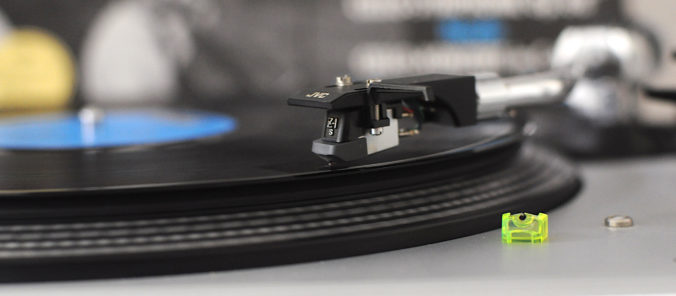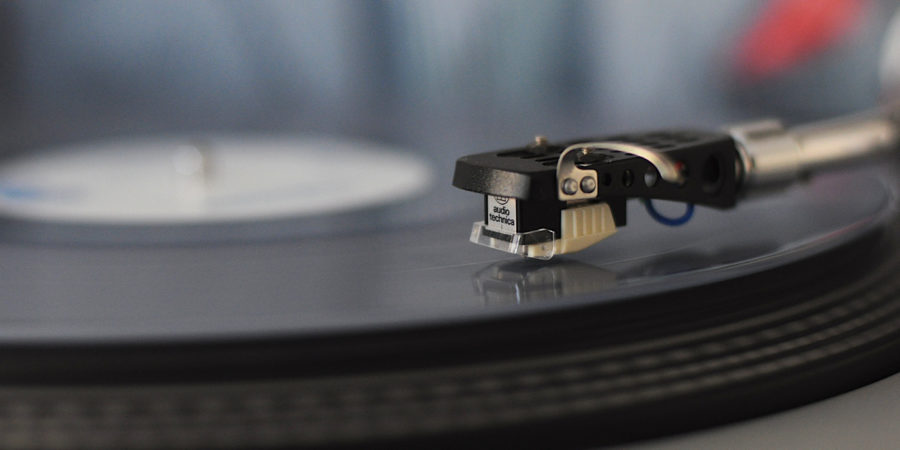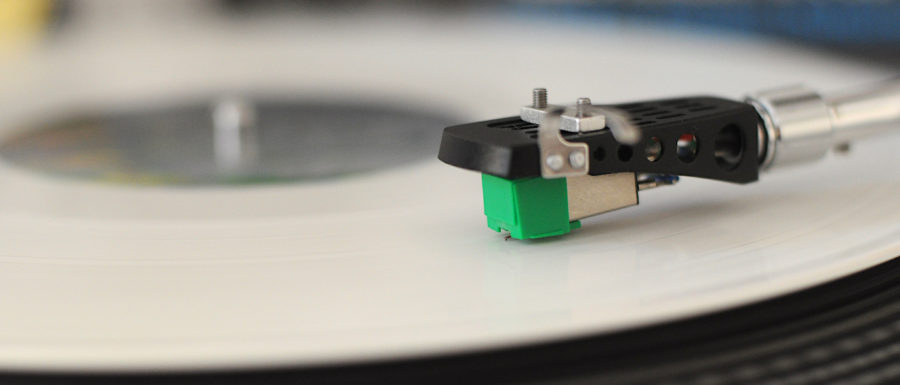Now I would like to cover a topic that has been on my mind for a while. It is a turntable comparison. True, there are two specific turntables selected here in Part 1. But these two represent both certain types of players and from different times. One is a quite modern belt-driven turntable called Pro-Ject 1xpression III (similar to the Pro-Ject Debut Carbon with acrylic platter (Amazon: https://amzn.to/2OtZBIY)), which I got from a hifi enthusiast friend as a permanent loan, for which I am very grateful, because this fact makes the comparison possible. And the other one is my old luminary, the old 70’s direct drive Toshiba/Aurex SR-255. The latter is also my test player for my reviews. It was refurbished by its previous owner, rewired and wrapped in a fancy white wooden frame.
Why this turntable comparison?
Very often, when reading in forums or Facebook groups about turntables, I come across discussions about which turntables are the better ones. Usually someone has a budget, wants to buy a turntable for it and asks the others in the group or forum what they would recommend. Within shortest time already something like a controversy develops.
One camp recommends a new one from Rega or Projekt with arguments like “The development has also gone forward with turntables”. And of course the “warranty” argument. The others recommend the old “warhorses” like Dual, Thorens or the Technics-like direct drives a la SL 1200. Their arguments are “Back then, quality was still built because they didn’t save on the material”, “They are super robust and still run after 40 years”, “Back then, people still had a clue about turntables” and so on.
But if I am completely without prior knowledge and prejudices now this actually asking, interested, I get with such arguments unfortunately no further. I now still don’t know which is really better, and I’m just as smart as before. Therefore, I thought I’d just compare two turntables from the different eras. I let them compete against each other.
With this record player comparison I would like to leave however the scientific aspect outside, and deal only with the hearing impression. I put myself in the position of a potential buyer, who compares turntables in a hi-fi store, in order to buy one in the end. If I am informed correctly, Phonophono in Berlin offers something like this. They have older Thorens and Technics and let them duel against new Regas.
The conditions of the turntable duel
But how can I set up the duel so that there are equal conditions for both players?
First, of course, you have to play the same sound source, i.e. record. More precisely the same test song that I have selected on the respective test record.
Of course, the rest of the hi-fi chain, i.e. preamplifier, amplifier and speakers must also be the same for both turntables. And last but not least, the cartridge is the same. Here I write consciously “same” and not “same”, because I have the test pickup, the Audio Technica AT 71 E, twice in my repertoire, and do not constantly build it from one to the other player. The needle, however, an elliptical replica needle by EVG from Japan, I will already change from one AT 71 to the other.
To this combination AT 71 and EVG needle can be said sonically: It is perhaps one of the most underestimated systems at all. As a predecessor of the AT 95 and the AT 91 it was “the” standard pickup of the late 70s, which was often installed in a bundle on the Japanese direct drives of that time. For me, it is the biggest positive surprise of recent times among my pickups (and I have a few).
That’s because, in my experience with it, it combines the positive qualities of its offspring, namely the straightforward pleasant frequency response of the AT95 and the charm and “sweet” highs of the AT 91. It doesn’t have the faults of either, such as the harsh, often sibilant highs of the AT 95 and the lack of resolution of the AT 91. The AT 71 is simply good. Especially with the elliptical EVG. And it can even create 3 D, i.e. a depth gradation of the sound. One would not trust such a budget pickup to do that.
I think my test conditions create some comparability.
My other hi-fi behind the turntable consists of the Phonopre Graham Slee Communicator 2, a Dual “Audiophile Concept” amplifier built by Rotel in the 80s, and Yamaha NS G 40 speakers.
Now to the different test records:
As already with my reviews about pickups, e.g. the AT 91 with Black Diamond needle, I would like to access four different test records, which also form different test scenarios at the same time.
The first test record is Carole King’s famous “Tapestry” album and from it immediately the first song “Feel The earth Move”. I chose this record and song for the needle tests because King’s voice is a challenge for any needle, and poorly scanning needles have been known to scratch.
Here I want to use it because the recording has a very special sound character. The middle part of the frequency band is emphasized, and the upper treble rolls off sharply. Here it is interesting how the turntables handle the recording and add their “mustard”.
Then follow two records that could well be used as demonstration discs in a high-end hi-fi store. One is “JTB” by the Jukka Tolonen Band, a fantastic fusion jazz recording from the late 70s. From it, the track “Space Cookie.”
And the other is Gregory Porter’s “Liquid Spirit” album, finally released on vinyl in 2019 in wonderful quality.
And last but not least comes the obligatory classical music test. Here, a Decca recording from the mid-60s, namely Haydn’s “Cello Concerto in C Major” played by the London Chamber Orchestra, serves to determine how the two competitors cope with the demands of classical music.
The turntable comparison in action
Test 1: Carole King “I Can Feel The Earth Move”:
We start with my good old Toshiba:
Immediately I notice what I also like about this Audio Technica system. It is able to present this very mid-heavy recording in a very pleasant way. As a listener, one senses good dynamics. The very strong mids are somewhat cushioned. The basses go deep, are a bit undefined. This may be due to the budget system as well as the recording. What is great is how the piano stands out from the speakers towards the middle of the song and stands in space. The spatial imaging of the AT 71 is again amazing here.
But how does the turntable do? The Carole King piece sounds good with the combination. One might very slightly have the feeling that the energy of the music is slowed down a bit.
I’m curious to see how it compares to the Pro-Ject with the same needle.
“Feel The Earth Move” is the first song on the record. In the lead-in groove, the first thing I notice about the Pro-Ject is that the silence is not black until the song. I can hear a very low hum, quiet but present. This did not set in until the needle was placed. A small minus point at the beginning.
But what you then get to hear is really great. Maybe you can say it like this: It’s a bit more of everything than with the Toshiba. This slightly restrained, positively put, has disappeared with the Pro-Ject.
It sounds directly more dynamic with the same system and the same needle. The bass range is more present, although not more defined, but it booms happily away. The mids come in bulky and passionate, no wonder with this mid-heavy number with that voice, but still in a way I wouldn’t have put it past this AT 71. This one was otherwise rather restrained for me. Treble comes in clean but is hard to judge on this song as it rolls off quite early.
The low end and stage is on par with the Toshiba.
Overall, the Pro-Ject and the AT 71 seem like a great team if it weren’t for that (engine) hum. That diminishes the enthusiasm. But maybe that can be fixed by checking the rubber suspension of the motor. Actually, a low-resonance acrylic platter is already installed.
From the sound of the music, the Pro-Ject takes a 1:0 lead. Both do their thing well, the Toshiba seems a touch more restrained and thus slightly slows down the dynamics and energy of the music. The Pro-Ject lets the energy out and blasts the power of King’s voice around your ears without, and this is the art, only exhaustingly “squawking” the mids.
Test 2: JTB with “Space Cookie”:
Now we turn to the high end recording of JTB. It comes from the heyday of analog sound recording, late 70s, just before digital recording took over and meant a step backwards for decades. The fusion jazz that the Jukka Tolonen Band play has very intricate sections, and makes great demands on the system and the needle to decipher this web of sound. Also, hopefully, it will become clear here to what extent the turntable itself participates in the formation of the sound.
This time we start in the turntable comparison with the more modern Pro-Ject.
Again, you can hear the distant hum when the needle is put down. Music starts and a short “wow” escapes me.
It starts dynamically. This recording, so insanely good, gives the players a chance to show what they can do. And pushes the AT 71 to its limits with the elliptical post needle. The Pro-Ject does this very well. The bass comes from very low and has contour, the mids are wonderfully fleshed out, the acoustic guitar at the beginning of the piece stands wonderfully in space and you can hear the strings and the wood vibrate. The separation of the instruments works well. Again, amazing for this inexpensive AT. The highs, heard on the high heads for example, are neither too shrill nor too rolled off. They show a very natural presentation. Also here the AT or better the EVG needle surprises with well resolved cymbal tones.
The whole performance of the Pro-Ject shows dynamic character, but also an impressive control of the sound. The frequency ranges blend beautifully into each other. Everything seems coherent and very realistic. The spatial representation is also convincing. Particularly striking is the accuracy with which the Pro-Ject’s carbon arm guides the tracking needle through the groove. The sound then thanks the good tracking with super-accurate treble representation, which would suggest more expensive grinds on the needle. If one did not know better.
And what does the Toshiba do in this turntable comparison?
It surprises me completely! Whereas with Carole King it sounded restrained and slowed down, it makes the “Space Cookie” really become one and almost “knocks me off my feet”.
I’m proud of my old warhorse. He really makes the jazz number come alive. This dynamic is fun. Again, the bass comes from the very bottom, has nice contour and blends beautifully into the midrange. The acoustic guitar, which is also great in space like Pro-Ject, gives me goosebumps down my spine. It has so much body and passion. The bass guitar in the last third of the track clearly stands out from the speakers and fills the room with a presence that I have never heard at this point with this instrument.
The treble is presented with just the right intensity, as with the Pro-Ject. Only: And here, with all the passion and perhaps because of this and the somewhat lost control from it, the Pro-Ject has the nose in front. The high heads sound minimally, really just a touch, less accurate on the Toshiba. They are still very well presented, and if you didn’t have the direct comparison, you wouldn’t notice it. But the Pro-Ject, or better its tonearm, samples the highs more controlled and accurately.
Of course, much is a matter of taste here, but I would give the point here to the Toshiba, which swept me away with its passion, even if it was minimally less accurate in the treble imaging. Both were great again, and can be classified as super recommendable after the first two tests.
The score is now 1:1 and we are looking forward to Gregory Porter’s “Musical Genocide”.
Test 3: Gregory Porter with “Musical Genocide”:
Gregory Porter’s great album “Liquid Spirit” was released in digital form in 2013, but not on vinyl until 2019. It is for me a typical example of a high quality modern recording, probably digital, distributed by the Blue Note label in high press quality.
From this album I choose the midtempo track “Musical Genocide”, which I also chose for my previous needle reviews and of which I know every note by now.
Here my beloved Direct Drive Toshiba SR-255 may start.
A strong performance of the combination of drive and system. From the first few beats it’s clear that the two like it dynamic. The bass line of the double bass sets the pace. It’s reproduced so realistically that you’d think you were in your living room. Drums, piano, high heads and the voice start one after the other. Listening is a lot of fun, because despite the balanced character of this pickup, which does not overemphasize any frequency range, dynamics and passion can be felt.
Still, the performance seems homey, you want to listen to the next number because it was so nice.
What I often missed in my needle reviews in this song sample was a certain spatial depth and separation of the instruments into layers. With the AT 71 and the Toshiba, that separation is noticeable. The piano plays clearly behind the saxophone and Porter is center stage in front of all the action.
If there could be minimal criticism, it was as if I heard a very slight uncleanness in Porter’s voice in places. As if it was presented more harshly than in reality, like a minimal scratching. This was audible at one or two points in the song. It was so slight that it could have been deceptive.
I’m curious to see how it compares. Now it’s the Pro-Ject’s turn:
Ok, phew. That will be difficult! In the turntable comparison, both are so similar in this song example. Again, the instruments and Porter’s voice are presented in a balanced yet dynamic manner that is a pleasure to listen to. No frequency range is overemphasized and bass, midrange and treble blend beautifully.
With this digital recording I always had the feeling that the highs, here consisting of the high heads and cymbals, are rolled off very slightly so as not to strain the listener’s ear and to create that homey atmosphere. This is transmitted very well by the pickup and both (!) turntables. The cymbals and high heads sound cleanly resolved with the EVG elliptical needle. Sure, there’s more to be done with a sharper grind, but you’d have to have direct comparison to hear that out.
If there are audible differences between the Toshiba and the Pro-Ject, they are in the barely noticeable range. It’s just a feeling, but the Toshiba was minimally more passionate and lively, the Pro-Ject more unstrained, more controlled. By the way, the slight scratchiness in Porter’s voice was also audible with the Pro-Ject. So either the groove is already scratched out by the frequent listening, or Porter’s voice went here intentionally in the direction of Joe Cocker. Never noticed it until now.
It’s a draw here, there’s no winner in this round. So the score is 2-2, as both get a point.
So the last round, which is about classical music, could be exciting and decisive.
Test 4: Rostropovich and the London Chamber Orchestra play Haydn’s Cello Concerto in C major.
Decca is known for having made particularly good and transparent classical recordings in the 1960s and 1970s, when sound technology was making giant leaps in quality. This example from 1965 is also one of them. People working today can take a leaf out of the book of the great work of the sound engineers of that time, who created such wonderful sounding recordings.
Getting this record out and putting it on gives me the greatest pleasure every time. And so it is now. The Pro-Ject with the AT 71 sounds so wonderfully airy and transparent and makes it clear right away: I can do classical music! Among the attributes that are important to me are room imaging, transparency, resolution and airiness, i.e. giving a feeling for the size of the room.
And these attributes are fully given with the Pro-Ject. One has the feeling that everything sounds as the engineers intended. The strings, so arguably the accompanying violins, as well as the main player, the cello, sound so real with that woody note that defines these instruments.
Again, no frequency range is very amplified, everything is balanced with the AT and yet in a way coherently gripping and passionate. I am very moved and almost have tears in my eyes. When you close your eyes as a listener, you sit in this hall and feel where the instruments are, you feel the size of the room. Simply great!
If there is a mini-criticism, or if there is something that other cartridges can do better, it might be to create a slightly wider stage. That’s where the AT comes into its own as a budget cartridge. The absolute low bass, which is not present here, is also not one of its strengths. But the airiness and coherence of the whole is very impressive!
And how does my old companion, the Toshiba, do?
I have goose bumps! It’s so exciting… With the same system, same needle, same cables, preamp, amp, speakers it sounds different. Only the path between the output of the cartridge and the output of the turntable is different, and it sounds different. But how? Worse? Better?
No, none of the above, just different. The sound of the Toshiba in this example is more powerful, the contrasts between the loud and soft passages are greater.
What impresses me most is the sound of the cello. It sounds so beautifully belly-wooden, as it simply sounds in nature. It is as if it were standing here in the living room with its player. This slightly less restraint than from the Pro-Ject does the solo instrument good here. It shows up more in the foreground.
The frequency ranges are also wonderfully harmonious here. The only difference is that you have the feeling of being closer to the action. You sit a few rows further forward. This has the advantage of feeling more of the passion of the game. On the other hand, you lose a bit of the feeling for the size of the room.
The whole thing sounds less airy than with the Pro-Ject, which also manages to convince with its unpretentiousness and slight restraint.
So who does the point go to? That’s clearly a matter of taste here…. That unbridled passion and power of the revised Direct Drive versus the super control and more restrained airiness of the Pro-Ject. Again, they both deserve a point.
So the final score is 3:3.
Resume
But what does all this tell us now?
The “battle” was here in part 1 of my turntable comparisons: An old 70’s Direct Drive versus a modern board player.
The Pro-Ject board player currently costs about 600 Euros, the Toshiba SR-255 about 650 DM when it was launched in 1977. The latter would cost about 1000 Euros today with this quality and the materials used (compare Technics 1200 MK7). It was rewired by its previous owner and has undergone an overhaul.
Exciting for me was: Has in these 44 years the development in the turntable area gone so far forward that one feels sonically with a 600 euro turntable a la Project a strong improvement over an old Direct Drive.
To do this, I think you first have to define what is good or bad about sound. There are various attributes in the sound that are perceived as pleasant or unpleasant. Transparency, accuracy, balance, for example, are positive sound attributes for the general public. Nevertheless, there is still a lot of room for taste. And that is also good. Tastes are different, and so everyone can put together his system according to his own taste in sound. We know it from the pickups. Some tend to sound brighter, others to be bass-heavy. And we choose according to taste.
And our opponents are both very good according to objective sound aspects. Here the taste decides!
Of course, there are much better turntables. These two are in the lower mid-range. But they are fun! Each in its own way.
Of course, I had the fun of assigning points in this turntable comparison. And it was very exciting and close in this race, a fair draw in the end.
I was very surprised by the turnaround in dynamics. With Carole King, the Pro-Ject showed its present and passionate side. This then changed in the following tests, where the “new” one was more the controlled, unexcited, but also unstressed one, and the old Toshiba the passionate, punchy one.
The smallest difference was heard in the new digital high-end recording of Gregory Porter. Here, even blindfolded, one would have had difficulty matching the turntables.
I hope I could now give new fire to the passionate discussions that arise in Facebook groups and forums, whether a new or old turntable is better, or calm them down a bit and blame it on taste.







